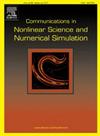A tristable nonlinear energy sink with time-varying potential barriers
IF 3.4
2区 数学
Q1 MATHEMATICS, APPLIED
Communications in Nonlinear Science and Numerical Simulation
Pub Date : 2024-12-21
DOI:10.1016/j.cnsns.2024.108559
引用次数: 0
Abstract
The multi-stable vibrational systems have attracted widespread attention due to their rich nonlinear dynamic phenomena. This study constructs a tristable nonlinear energy sink with time-varying potential barriers (VP-TNES) for the first time, aimed at enhancing vibration suppression efficiency of traditional TNES. The VP-TNES builds time-varying potential barriers with symmetrical magnetic oscillators. Then, the VP-TNES is coupled with a linear oscillation (LO). A new nonlinear model of 4-degree-of-freedom (4DOF) coupled system of TNES control is developed, distinct from the previous 2DOF design. The effect of the movable magnets’ spring stiffness on the dynamics and vibration suppression efficiency of the VP-TNES is investigated. The results demonstrate that the barrier depths are dynamically adjusted. Therefore, the VP-TNES crosses the potential barriers more easily, leading to chaotic inter-well oscillations. Consequently, this nonlinear strong modulated phenomenon can improve the vibration reduction performance of VP-TNES, especially for low-amplitude excitation vibrations. Moreover, the design principles for the symmetrical magnetic oscillators are provided. This study proposed a TNES with time-varying potential barriers and clarified its vibration reduction mechanism. The dynamics adjustment phenomenon can not only enhance the vibration reduction efficiency of traditional TNES, but also be applied to other fields of vibration energy regulation.
具有时变势垒的三稳定非线性能量汇
多稳定振动系统因其丰富的非线性动力学现象而受到广泛关注。本文首次构建了具有时变势垒的三稳定非线性能量汇(VP-TNES),旨在提高传统的时变势垒能量汇的抑振效率。VP-TNES利用对称磁振子构建时变势垒。然后,VP-TNES与线性振荡(LO)耦合。提出了一种新的四自由度耦合系统非线性控制模型,不同于以往的二自由度系统设计。研究了动磁体的弹簧刚度对VP-TNES的动力学特性和抑振效率的影响。结果表明,障壁深度是动态调节的。因此,VP-TNES更容易越过势垒,导致混沌的井间振荡。因此,这种非线性强调制现象可以提高VP-TNES的减振性能,特别是对低振幅的激励振动。并给出了对称磁振子的设计原则。本文提出了一种时变势垒结构,并阐明了其减振机理。这种动态调节现象不仅可以提高传统振动能量调节系统的减振效率,而且可以应用于其他振动能量调节领域。
本文章由计算机程序翻译,如有差异,请以英文原文为准。
求助全文
约1分钟内获得全文
求助全文
来源期刊

Communications in Nonlinear Science and Numerical Simulation
MATHEMATICS, APPLIED-MATHEMATICS, INTERDISCIPLINARY APPLICATIONS
CiteScore
6.80
自引率
7.70%
发文量
378
审稿时长
78 days
期刊介绍:
The journal publishes original research findings on experimental observation, mathematical modeling, theoretical analysis and numerical simulation, for more accurate description, better prediction or novel application, of nonlinear phenomena in science and engineering. It offers a venue for researchers to make rapid exchange of ideas and techniques in nonlinear science and complexity.
The submission of manuscripts with cross-disciplinary approaches in nonlinear science and complexity is particularly encouraged.
Topics of interest:
Nonlinear differential or delay equations, Lie group analysis and asymptotic methods, Discontinuous systems, Fractals, Fractional calculus and dynamics, Nonlinear effects in quantum mechanics, Nonlinear stochastic processes, Experimental nonlinear science, Time-series and signal analysis, Computational methods and simulations in nonlinear science and engineering, Control of dynamical systems, Synchronization, Lyapunov analysis, High-dimensional chaos and turbulence, Chaos in Hamiltonian systems, Integrable systems and solitons, Collective behavior in many-body systems, Biological physics and networks, Nonlinear mechanical systems, Complex systems and complexity.
No length limitation for contributions is set, but only concisely written manuscripts are published. Brief papers are published on the basis of Rapid Communications. Discussions of previously published papers are welcome.
 求助内容:
求助内容: 应助结果提醒方式:
应助结果提醒方式:


